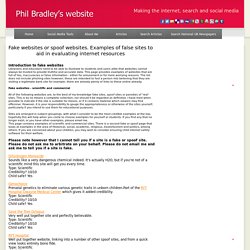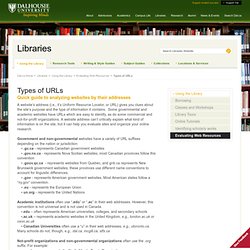

Fake websites, Spoof websites, science spoofs, commercial fake sites. Introduction to fake websites Librarians and educators need to be able to illustrate to students and users alike that websites cannot always be trusted to provide truthful and accurate data.

This page provides examples of websites that are full of lies, inaccuracies or false information - either for amusement or for more worrying reasons. The list does not include phishing sites however; these are intended to fool a person into believing that they are visiting a legitimate bank site for example; there are already plenty of links to these online already. Fake websites - scientific and commercial All of the following websites are, to the best of my knowledge fake sites, spoof sites or parodies of 'real' sites. Sites are arranged in subject groupings, with what I consider to be the most credible examples at the top; hopefully this will help when you come to choose examples for yourself or students.
This page contains examples of scientific and commercial sites. Dihydrogen Monoxide. Evaluate Web Pages. 6 Criteria for Websites - Libraries - Dalhousie University. Website Checklist - Libraries - Dalhousie University. Types of URLs - Libraries - Dalhousie University. A website’s address (i.e., it’s Uniform Resource Locator, or URL) gives you clues about the site’s purpose and the type of information it contains.

Some governmental and academic websites have URLs which are easy to identify, as do some commercial and not-for-profit organizations. A website address can’t critically explain what kind of information is on the site, but it can help you evaluate sites and organize your online research. Government and non-governmental websites have a variety of URL suffixes depending on the nation or jurisdiction: • .gc.ca - represents Canadian government websites • .gov.ns.ca - represents Nova Scotian websites; most Canadian provinces follow this convention • .gouv.qc.ca - represents websites from Quebec, and gnb.ca represents New Brunswick government websites; these provinces use different name conventions to account for linguistic differences. • .gov - represents American government websites.
Home - Evaluation of health information on the Web - Subject Guides at Dalhousie University. There are six broad criteria for evaluation of health information you find on the web.

They are: Credibility, Content, Disclosure, Links, Design and Interactivity. Each of the criteria is described in more depth in the boxes below. These criteria were originally defined in Policy Paper: Assessing the quality of health information on the internet published in 1998. Variations on the criteria have been used widely ever since. Another good practice is to look for the HONCode Certificate symbol. Is certificate to health sites who comply with ethical and trustworthy practices And as a general rule of thumb when looking for health information, stick to reputable sites from educational instututions, government sources, and health related associations and societies.
Web page evaluation checklist. Microsoft - Critical thinking. International Society for Technology in Education. In the context of web context: How to check out any Web page. Mediactive - Creating a User's Guide to Democratized Media. We the Media. Dan Gillmor. The Web Credibility Project - Stanford University: Publications.
Note: Articles available from the ACM Digital Library require a subscription.

Rieh, S.Y. & Danielson, D.R. (2007). Credibility: A multidisciplinary framework. B. Cronin (Ed.), Annual Review of Information Science and Technology, Vol. 41, 307-364. Information Today, Inc. Fogg, B.J., Cuellar, G., & Danielson, D.R. Danielson, D.R. (2005). Book Information Fogg, B.J. (2003). Full text from ACM Digital Library | Persuasive Technology Lab Report Fogg, B.J. (2003). Book Information Fogg, B.J., Marshall, J., Kameda, T., Solomon, J., Rangnekar, A., Boyd, J., & Brown, B. (2001). Full text from ACM Digital Library Fogg, B.J., Marshall, J., Laraki, O., Osipovich, A., Varma, C., Fang, N., Paul, J., Rangnekar, A., Shon, J., Swani, P., & Treinen, M. (2001). Full text from ACM Digital Library. Detecting Bull: How to Identify Bias and Junk Journalism in Print, Broadcast and on the Wild Web.